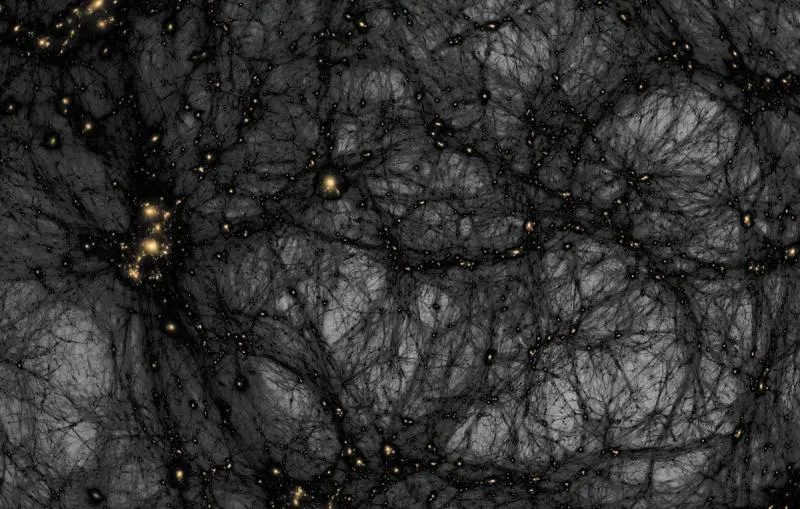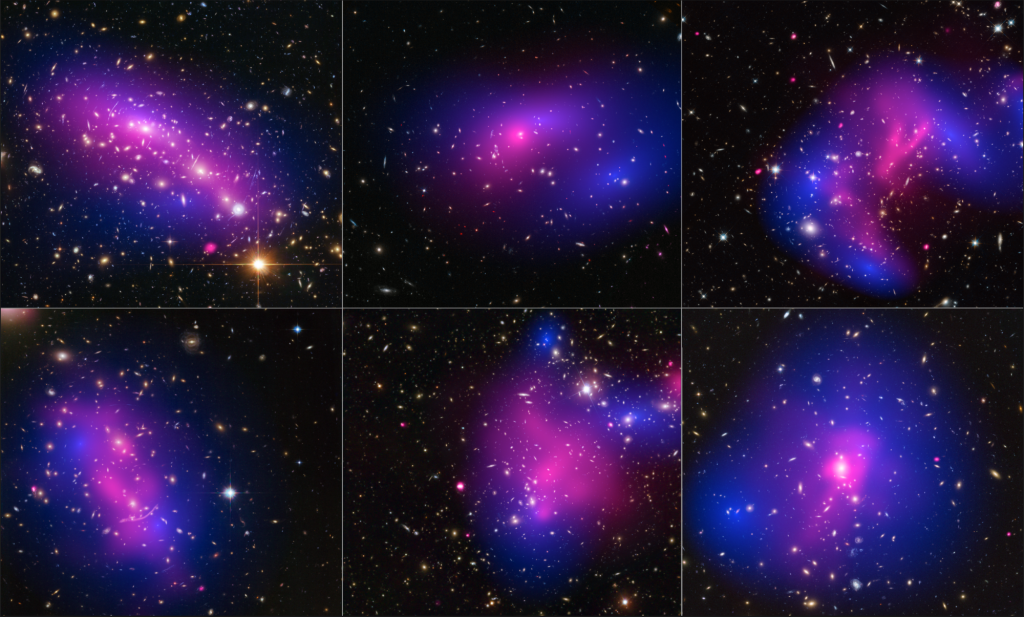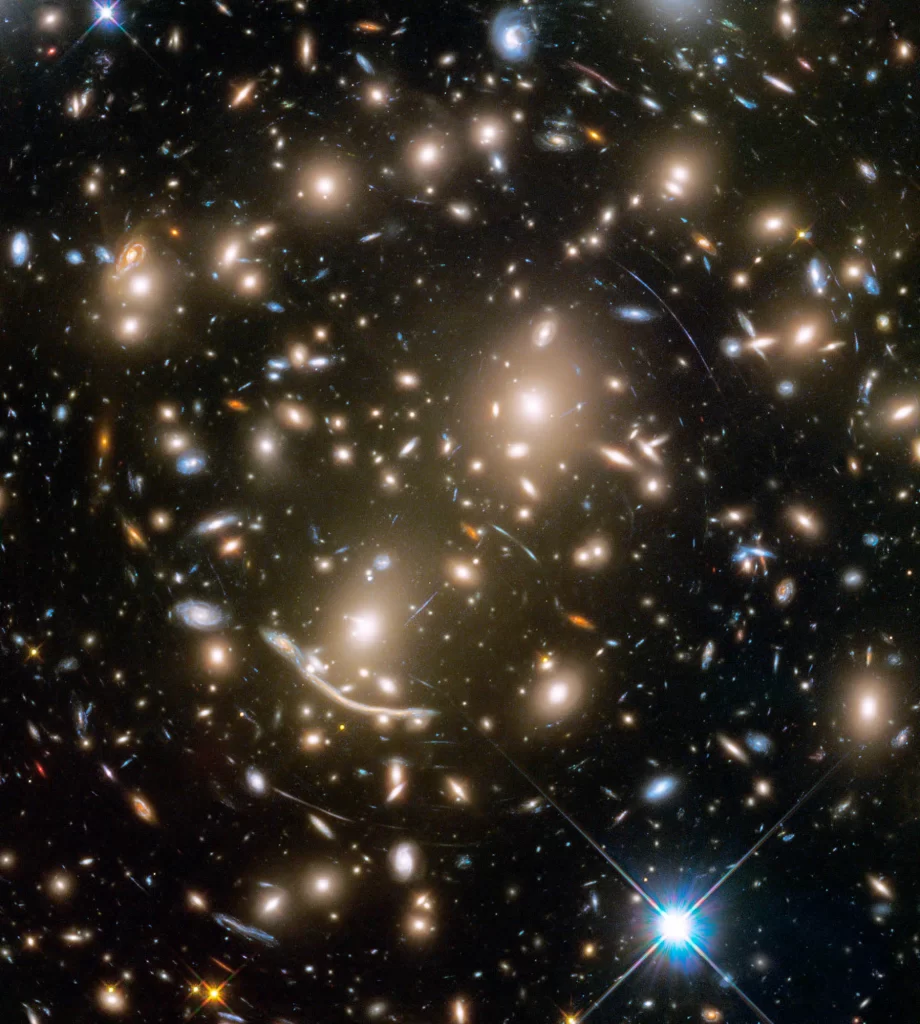Table of Contents
The Cosmic Mystery of Missing Mass
The cosmos is a vast, intricate network of galaxies, stars, and cosmic structures, yet most of its mass remains unseen. While visible matter—stars, gas, and dust—creates the luminous spectacle we observe, calculations suggest that an overwhelming majority of the universe’s mass is missing. This discrepancy became apparent when astronomers noticed that galaxies were rotating at speeds that defied Newtonian physics, suggesting the presence of an invisible force. This unseen influence, identified as dark matter, provides the additional gravity needed to hold these structures together. Unlike ordinary atoms, it does not interact with electromagnetic radiation, making it impossible to detect through conventional telescopes.
Even though dark matter does not emit or reflect light, its presence is inferred through its gravitational effects. One of the earliest hints came from galaxy clusters, where the movement of individual galaxies suggested that their combined visible mass was insufficient to explain their motion. Later, studies of gravitational lensing—where light from distant objects bends around massive unseen structures—provided further confirmation. Without this invisible mass, galaxies would tear apart under their own rotation. Scientists continue to investigate its properties using advanced technology, from deep-space observations to underground particle detectors. Although much about it remains unknown, ongoing research is refining our understanding of this mysterious component of the cosmos.
The Unseen Influence on Galactic Motion
In the 1930s, Swiss astronomer Fritz Zwicky made a groundbreaking observation while studying the Coma Cluster, a dense collection of galaxies. He noticed that the galaxies were moving so rapidly that their visible mass alone could not generate enough gravity to keep them bound together. Applying the virial theorem, a mathematical principle used to calculate the total mass of a system based on motion, he determined that an enormous portion of the cluster’s mass was missing. To explain this anomaly, he proposed the existence of an invisible form of matter, which he called “dunkle Materie.” Despite this revelation, his theory gained little traction at the time, as most astronomers believed that only the observable universe contributed to gravitational forces.
Four decades later, dark matter received renewed attention when Vera Rubin and Kent Ford studied spiral galaxies. Using advanced spectroscopic techniques, they found that stars at the outer edges of galaxies were orbiting just as fast as those near the center, contradicting Newtonian physics. If only visible mass were influencing these stars, their velocities should decrease with distance, much like planets in the solar system. However, they remained unexpectedly high, suggesting the presence of additional unseen mass. Their work provided compelling evidence that dark matter was not confined to galaxy clusters but was a widespread cosmic phenomenon. This discovery reshaped astrophysics, confirming that much of the universe is governed by forces beyond what is directly observable.
The Evidence That Dark Matter Exists
Unlike ordinary matter, which interacts with light, much of the universe’s mass remains unseen. One of the earliest hints of its existence came from galactic rotation curves, which revealed an unexpected phenomenon. According to Newtonian physics, stars farther from the galactic center should move slower than those closer in, much like planets orbiting the Sun. However, observations showed that outer stars orbit at nearly the same speed as inner stars, contradicting expectations. This suggests an unseen mass generating additional gravity, preventing these galaxies from flying apart. Without the gravitational pull of dark matter, galaxies should be structurally unstable. Astronomers confirmed this effect in numerous galaxies, reinforcing the idea that a mysterious, non-luminous substance pervades the cosmos.
Another strong piece of evidence comes from gravitational lensing, a process predicted by Einstein’s theory of general relativity. When light from distant galaxies passes near a massive object, its path bends due to gravity. Scientists have observed distorted light patterns that suggest the presence of unseen mass, providing another clue for dark matter. Additionally, studies of the cosmic microwave background (CMB), the afterglow of the Big Bang, reveal density fluctuations that align with theoretical predictions of a universe dominated by more than just visible matter. Large-scale galaxy distributions also follow patterns that indicate hidden gravitational influences. While direct detection remains elusive, the indirect evidence supporting this cosmic enigma continues to grow.
The Search for an Elusive Explanation
Scientists have explored multiple possibilities to explain the mysterious missing mass of the universe. The most widely accepted hypothesis involves Weakly Interacting Massive Particles (WIMPs), theoretical particles that have mass and interact gravitationally but rarely with normal matter. If these particles exist, they could explain the unseen gravitational effects detected in galaxies and clusters. WIMPs are actively being searched for in underground detectors like XENON1T and LUX-ZEPLIN, where scientists hope to detect rare interactions with ordinary atoms. Another candidate, axions, is an extremely light particle proposed to explain anomalies in quantum chromodynamics. If axions exist, they might also be responsible for the unexplained polarization of light in space. These particles remain hypothetical, but their detection would revolutionize physics.
Some scientists propose that rather than an undiscovered particle, the laws of gravity may require modification to explain cosmic observations. One alternative, Modified Newtonian Dynamics (MOND), suggests gravity behaves differently at low accelerations, potentially eliminating the need for dark matter by attributing galaxy rotation to changes in gravitational force over vast distances. Another theory, emergent gravity, posits that dark matter might be a consequence of the behavior of space-time. However, these theories do not fully account for the gravitational lensing effects observed in deep-space studies, leaving the nature of this invisible mass unresolved.

Ralf Kaehler/SLAC National Accelerator Laboratory, American Museum of Natural History
The Mathematics Behind Hidden Mass
The unseen influence shaping galaxies and cosmic structures is deeply rooted in mathematical equations. One key relationship, the Tully-Fisher Relation, links a galaxy’s luminosity to its rotation speed, suggesting a hidden mass component. This empirical formula shows that brighter galaxies rotate faster, but the measured velocities far exceed what visible matter alone can explain. Another critical framework comes from Einstein’s General Relativity, which describes gravity as the curvature of space-time. The Einstein Field Equations, which govern how mass and energy influence this curvature, predict that galaxies and galaxy clusters should contain far more mass than what is visible. The gravitational effects observed in these structures suggest the presence of an unseen force, which researchers attribute to dark matter.
Cosmology further refines this concept through the Lambda Cold Dark Matter (ΛCDM) model, the leading theoretical framework explaining the universe’s evolution. In this model, the universe is composed of roughly 27% dark matter, 68% dark energy, and just 5% ordinary matter. The equations within ΛCDM help predict large-scale structures, including galaxy formation and the cosmic web. Without this hidden mass, the distribution of galaxies and their observed motion would be mathematically inconsistent with our current understanding of physics. While the equations provide strong indirect evidence, scientists continue refining their models, searching for a direct mathematical description of dark matter’s fundamental nature, hoping to unify its effects with known physical laws.
The Hunt for the Invisible Particle
Scientists employ various high-tech methods to uncover the true nature of the unseen mass shaping the cosmos. One primary approach involves direct detection experiments, where massive underground detectors, such as XENON1T and LUX-ZEPLIN, are designed to capture rare interactions between elusive particles and ordinary atoms. These detectors are buried deep below the Earth’s surface to shield them from cosmic radiation that could interfere with results. Another approach involves particle accelerators, like the Large Hadron Collider (LHC), which smashes protons together at near-light speeds. Scientists analyze these collisions for unusual energy signatures that could indicate the existence of dark matter. If detected, these signals could confirm long-standing theoretical predictions and provide insight into this invisible cosmic component.
Beyond Earth-based detectors, astronomers also search for dark matter using powerful space telescopes. The Fermi Gamma-ray Telescope scans the universe for high-energy emissions that may result from dark matter particles colliding and annihilating each other. Scientists believe that if these particles exist, they might decay into detectable gamma rays, particularly near the galactic center, where high concentrations of this unseen mass are expected. Additionally, gravitational lensing studies track how light bends around massive objects, helping to map dark matter’s distribution across the universe. Despite decades of research, no direct evidence has been found, but each experiment brings scientists closer to unlocking the mystery behind this hidden force shaping cosmic evolution.
The Foundation of Cosmic Structure
Galaxies formed not by chance but through the influence of an unseen force that shaped the universe’s early structures. After the Big Bang, ordinary matter existed as a hot plasma, preventing clumping due to high energy, while invisible mass created gravitational wells that guided galaxy formation. This dark matter served as a cosmic scaffold, attracting gas and dust to form the first stars and galaxies. Without dark matter, the universe would lack its structured web of galaxy clusters, a fact supported by N-body simulations that fail to replicate cosmic evolution without it.
As galaxies evolved, dark matter continued playing a critical role in their stability and distribution. Observations reveal that galaxies are embedded in vast halos of this unseen mass, providing the additional gravity needed to prevent them from dispersing. Dwarf galaxies, some of the oldest structures in the universe, are believed to have formed within dense clumps of dark matter, further supporting its role in cosmic evolution. Additionally, large-scale surveys of galaxy distributions align with predicted models that include this hidden force. Without its presence, galaxies would be much smaller, scattered, or possibly nonexistent. Understanding its influence remains crucial to unraveling how the intricate architecture of the universe developed over billions of years.
A Collision That Reveals the Unseen
The Bullet Cluster offers compelling evidence for an unseen cosmic force, formed by the collision of two massive galaxy clusters at high speeds. As they merged, hot gas, which contains most visible mass, was slowed by friction, while the galaxies passed through with minimal resistance. Gravitational lensing studies showed that most of the total mass is located in areas devoid of luminous matter, indicating an invisible gravitational force at play, thereby strongly supporting the existence of dark matter in the universe.
Research into the Bullet Cluster has refuted alternative gravitational theories like Modified Newtonian Dynamics (MOND), which cannot explain the observed gravitational lensing that shows mass concentration in areas devoid of visible matter. Similar patterns in other galaxy cluster collisions, such as MACS J0025.4-1222, further support the existence of dark matter as a unique mass component, highlighting that an invisible force significantly influences the universe’s large-scale structures.
Balancing Forces in Cosmic Evolution
The universe’s expansion is shaped by two opposing forces—one that pulls and one that pushes. While dark energy is responsible for the accelerated expansion of space, an invisible mass counters this effect by exerting gravitational attraction. Scientists have observed that galaxies do not simply drift apart; instead, they move within a complex cosmic web of filaments and clusters, structures that could not have formed without an unseen gravitational force. This influence is evident in baryon acoustic oscillations, large-scale ripples in the cosmic background radiation left over from the early universe. These oscillations serve as a cosmic ruler, showing that an unknown mass component, later identified as dark matter, was essential in shaping galaxies and their large-scale distribution.
Precision measurements from the Planck satellite provide a breakdown of the universe’s composition, revealing that it consists of approximately 27% dark matter, 68% dark energy, and only 5% ordinary matter. Without this unseen mass, galaxies and clusters would not have formed as they have, and cosmic expansion would have followed a different trajectory. Unlike dark energy, which pushes space outward, dark matter provides the necessary gravitational pull to slow down rapid expansion, preventing galaxies from dispersing too quickly. This delicate balance between these two mysterious components governs the structure of the cosmos. Future missions, like the Euclid telescope, aim to refine our understanding of how these forces interact and whether unknown physics may be influencing cosmic evolution.
Exploring Alternative Explanations
While many researchers focus on undiscovered particles, some scientists argue that the missing mass of the universe may have a completely different origin. One possibility involves primordial black holes, small black holes that could have formed just after the Big Bang due to density fluctuations in the early universe. Unlike supermassive black holes found at galaxy centers, these could be scattered throughout space, exerting gravitational influence without emitting light. If they make up a significant portion of unseen mass, their presence could explain galactic rotation curves without the need for exotic particles. However, searches for such objects, including gravitational microlensing studies, have yet to find enough evidence to confirm them as the dominant source of dark matter.
Beyond black holes, some researchers suggest that our understanding of gravity itself may be incomplete. In certain quantum gravity models, gravity may behave differently at cosmic scales, giving the illusion of additional mass where none exists. The holographic principle, which suggests that the universe’s fundamental information is encoded on a lower-dimensional boundary, presents another possibility. If gravity emerges as a large-scale effect rather than a fundamental force, this could explain why dark matter appears to exist without requiring new particles. While these ideas challenge conventional physics, they remain speculative until observational data or experiments provide measurable evidence supporting a radical shift in our understanding of the universe’s structure.
A New Era of Discovery
Advancements in technology are bringing scientists closer to solving one of the universe’s greatest mysteries. The Vera C. Rubin Observatory, set to begin operations soon, will conduct a decade-long sky survey to track the distribution of mass across billions of galaxies. By measuring how galaxies move and how light bends around them, researchers hope to map the unseen gravitational influence shaping cosmic structures. Similarly, the Euclid Telescope, launched by the European Space Agency, is designed to study the universe’s large-scale structure, providing data on how galaxies cluster. These projects aim to refine models of cosmic evolution and could reveal whether dark matter is a particle, a modification of gravity, or something entirely unexpected within our current understanding of physics.
In addition to observational advancements, new theoretical models continue to emerge. One promising idea, Self-Interacting Dark Matter (SIDM), suggests that this unseen mass may not be entirely passive but could interact with itself in ways that influence galaxy formation. If true, this could explain discrepancies in galaxy rotation curves that traditional models fail to resolve. Meanwhile, deep-space observatories like NASA’s Nancy Grace Roman Space Telescope will study how this invisible force weaves through the cosmic web. Future discoveries could fundamentally reshape particle physics, leading to breakthroughs in quantum mechanics and relativity. As experiments become more precise, the coming decades may finally unravel the true nature of dark matter, transforming our understanding of the universe.

Rethinking the Foundations of Physics
If decades of research fail to reveal the nature of the universe’s missing mass, scientists may need to reconsider fundamental theories. Some physicists propose that a new framework, such as quantum gravity, could eliminate the need for an unseen mass by altering our understanding of gravitational interactions. Others suggest modifications to Einstein’s General Relativity, arguing that gravity might behave differently at cosmic scales than previously thought. The MOND (Modified Newtonian Dynamics) hypothesis, for instance, attempts to explain galaxy rotation curves without invoking an invisible substance. While these alternative theories remain controversial, the inability to directly detect dark matter would force physicists to explore radical ideas that challenge long-standing assumptions about space, time, and the fundamental forces of nature.
Even if current methods fail, it does not mean that dark matter does not exist—it may simply require more advanced detection technology. Future breakthroughs in particle physics could reveal interactions that are currently too weak to observe. If this hidden mass consists of axions or sterile neutrinos, specialized detectors not yet invented may be required to confirm their presence. Some researchers believe that space-based observatories, capable of scanning the universe at unprecedented precision, will eventually uncover its secrets. Whether through direct detection or theoretical shifts, the search continues to be one of the most ambitious pursuits in modern science, expanding humanity’s quest to understand the true nature of the cosmos.
How useful was this post?
Click on a star to rate it!
Average rating / 5. Vote count:
No votes so far! Be the first to rate this post.
Author
-
Meet Dr. Kendall Gregory, a highly accomplished professional with a remarkable academic background and a deep passion for empowering individuals through knowledge. Dr. Gregory’s educational journey began with a Bachelor of Science degree, followed by a Doctor of Chiropractic Medicine, focusing on diagnosing and treating musculoskeletal conditions. He further expanded his expertise with a Master's degree in Oriental Medicine, specializing in acupuncture and Chinese herbology, and a Master's degree in Health Care Administration, emphasizing his dedication to improving healthcare systems. Dr. Gregory combines his extensive knowledge and practical experience to provide comprehensive and integrative healthcare solutions. Through his writings, he aims to inspire individuals to take charge of their health and make informed decisions.
View all posts







